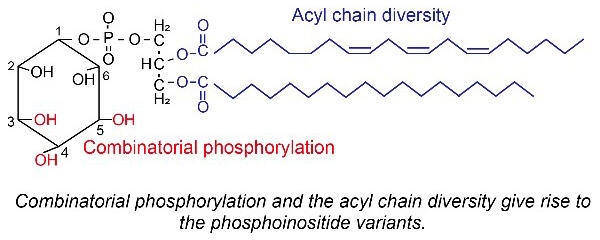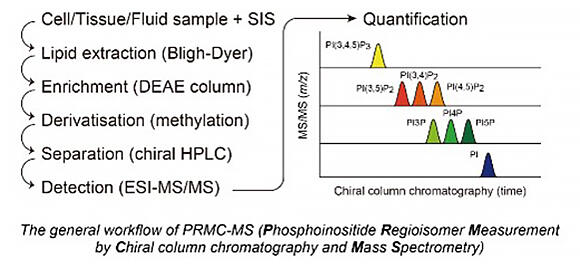Dysregulated metabolism of phosphoinositides (PIPs), which constitute the plasma membrane, leads to a variety of diseases, including cancer, neurodegenerative diseases, allergies, and metabolic abnormalities. Unfortunately, however, PIPs levels in humans and experimental animals could hardly be assessed. In collaboration with Akita University, Kobe University, and Aichi Cancer Center, the research group comprising Technical Assistant Shin Morioka, Research technician Toshiyoshi Yamamoto, Associate Professor Junko Sasaki, and Professor Takehiko Sasaki, all from the Medical Research Institute, Tokyo Medical and Dental University, developed the world's first PRMC-MS, a comprehensive analysis method for phosphoinositides. The research group then revealed the PIPs variant composition specific to cancer and the existence of PIPs in the extracellular milieu. Professor Sasaki stated, "It is getting clearer that PIPs variant compositions can be useful for determining disease prognosis and drug susceptibility. In the future, we would like to explore the development of therapeutic strategies and diagnostic techniques targeting phosphoinositide variants." The findings of this group have been published in the online version of Nature Communications.

Due to the phosphorylation pattern and the acyl chain composition of phosphatidylinositol, various PIPs variants exist in animals. In the current study, the researchers established a comprehensive analysis of PIPs variants (PRMC-MS method) using liquid chromatography and mass spectrometry. Practically, PIPs from a biological sample are concentrated, derivatized, and separated on a chromatography column to identify and quantify molecules using a mass spectrometer. PRMC-MS is characterized by a wide dynamic range (5 fmol to 50 pmol), a high sensitivity (c.a. 100 amol), and good repeatability. This method applies to yeast, experimental animals (Xenopus laevis, Drosophila, and mice), and human-derived samples and simultaneously detects a few hundreds of phosphoinositide variants.

Analyses of PIPs dynamics by PRMC-MS showed that certain variants were increased by stimulation with epidermal growth factor, oxidative stress, and ectopic expression of the Shigella flexneri IpgD in cultured cells. In contrast, some variants were decreased by Copanlisib treatment, which is being developed as a cancer treatment. In animal studies using mice lacking the tumor suppressor Pten, the researchers successfully identified the variants that accumulate in prostate cancer tissues at high levels.
PIPs are well recognized as plasma membrane components, but their extracellular presence has remained unknown. The PRMC-MS method revealed the presence of several PIPs variants in cell culture supernatants. The quality and the quantity of PIPs secreted extracellularly vary depending on the type and nature of the cell. The culture supernatants of cells overexpressing the oncogene PIK3CA mutant show increased levels of certain PIPs variants, which are mobilized, at least in part, in the form of exosomes.
Professor Sasaki stated, "Our laboratory is currently analyzing dozens of samples a day to analyze PIPs variants in healthy subjects and cancer patients. We found that these individuals can be classified into three major groups based on PIPs signatures, and it has become clear that disease prognosis is poor in a specific group. At the cellular level, drug susceptibility can be predicted by PIPs profiling with an accuracy of approximately 80% for drugs targeting PIPs-related proteins. By analyzing PIPs variants in surgical specimens in collaboration with clinicians in our university hospital, we aim to facilitate the development of new treatment strategies and diagnostic technologies."
This article has been translated by JST with permission from The Science News Ltd.(https://sci-news.co.jp/). Unauthorized reproduction of the article and photographs is prohibited.




